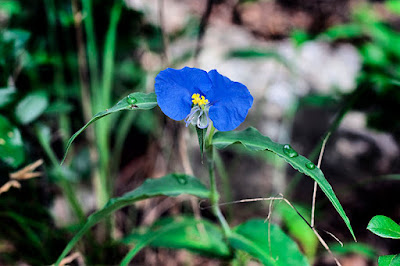If you can, take a camera, too!
That's what I did one recent morning. I wasn't out long, about an hour. Here are a few photos of what I saw.
Just as I was starting, before I even left our driveway, I saw this small lizard. It's a ground skink, Scincella lateralis, about 6 inches long. It was warming itself on the pavement and didn't run away when I approached.
Here's a photo of a Whitemouth dayflower, Commelina erecta. It was growing in the dappled shade of some trees and still had a bit of dew on it. It actually has 3 petals - the 2 large blue ones and a small white one in between and below. That might be the origin of the name.
Next, I came across a woolly caterpillar. The photo isn't taken from the best angle, but I didn't want to disturb the caterpillar. I haven't been able to identify it, so any help would be appreciated. We've seen several of these recently, so I'm quite curious to learn what it is.
This is a tiny lace cactus, Echinocereus reichenbachii. It's only about one inch in diameter and was growing by itself among some rocks. I normally see them in groups or clumps, so this lonely specimen was interesting. I'm fascinated by the regular, geometric symmetry of the needles.
As I was walking along a dirt road, I saw these animal tracks. The ground was a bit soft from recent rains and you could clearly see the path the animal had taken and which I was inadvertently following. I can't identify the animal, but I suspect a coyote or a fox. As before, I would appreciate any help.
This little starburst is Mountain Pink, Centaurium beyrichii.
Here's a Narrowleaf yucca, Yucca glauca. The flowers are at the end of a 4 to 5 foot spike. This year, because of all the rains, many yuccas are flowering, but most I've seen have the flower spike eaten by white tailed deer long before the blooms open.
There are many Black-eyed Susans, Rudbeckia hirta var. pulcherrima, in bloom right now. They tend to occur in large groups, covering a big area, and forming dense patches. These grow in the full sun.
The Winecups, Callirhoe digitata, are also out, but are not nearly as common as the Black-eyed Susans. You have to be alert to spot them, but their bright red wine color helps.
Here's another Black-eyed Susan, with an interesting color variation. While the ones I saw earlier had uniformly yellow petals, this one had brown patches at the petal base.
That's not a bad haul for a one hour hike! I've learned to slow down on my hikes and really look at what's around. It doesn't take much effort or fancy equipment, just awareness.
I hope you get a chance to go on your own hikes and observe nature's beauty.
Subscribe to:
Post Comments (Atom)










No comments:
Post a Comment